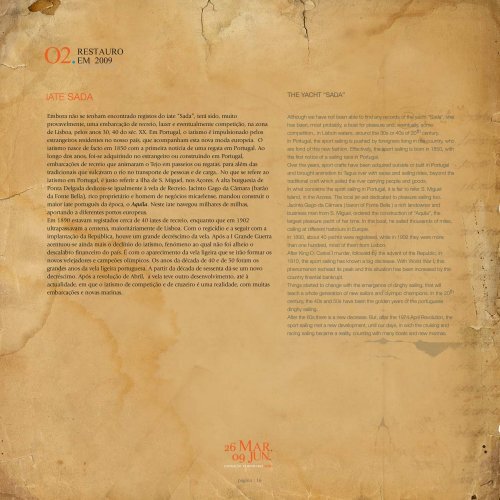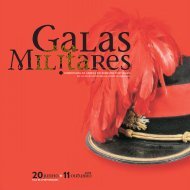Versão digital - Museu de Angra do Heroísmo
Versão digital - Museu de Angra do Heroísmo
Versão digital - Museu de Angra do Heroísmo
Create successful ePaper yourself
Turn your PDF publications into a flip-book with our unique Google optimized e-Paper software.
IATE SADA<br />
Embora não se tenham encontra<strong>do</strong> registos <strong>do</strong> iate “Sada”, terá si<strong>do</strong>, muito<br />
provavelmente, uma embarcação <strong>de</strong> recreio, lazer e eventualmente competição, na zona<br />
<strong>de</strong> Lisboa, pelos anos 30, 40 <strong>do</strong> séc. XX. Em Portugal, o iatismo é impulsiona<strong>do</strong> pelos<br />
estrangeiros resi<strong>de</strong>ntes no nosso país, que acompanham esta nova moda europeia. O<br />
iatismo nasce <strong>de</strong> facto em 1850 com a primeira notícia <strong>de</strong> uma regata em Portugal. Ao<br />
longo <strong>do</strong>s anos, foi-se adquirin<strong>do</strong> no estrangeiro ou construin<strong>do</strong> em Portugal,<br />
embarcações <strong>de</strong> recreio que animaram o Tejo em passeios ou regatas, para além das<br />
tradicionais que sulcavam o rio no transporte <strong>de</strong> pessoas e <strong>de</strong> carga.. No que se refere ao<br />
iatismo em Portugal, é justo referir a ilha <strong>de</strong> S. Miguel, nos Açores. A alta burguesia <strong>de</strong><br />
Ponta Delgada <strong>de</strong>dicou-se igualmente à vela <strong>de</strong> Recreio. Jacinto Gago da Câmara (barão<br />
da Fonte Bella), rico proprietário e homem <strong>de</strong> negócios micaelense, man<strong>do</strong>u construir o<br />
maior iate português da época, o Aquila. Neste iate navegou milhares <strong>de</strong> milhas,<br />
aportan<strong>do</strong> a diferentes portos europeus.<br />
Em 1890 estavam regista<strong>do</strong>s cerca <strong>de</strong> 40 iates <strong>de</strong> recreio, enquanto que em 1902<br />
ultrapassavam a centena, maioritáriamente <strong>de</strong> Lisboa. Com o regicídio e a seguir com a<br />
implantação da República, houve um gran<strong>de</strong> <strong>de</strong>créscimo da vela. Após a I Gran<strong>de</strong> Guerra<br />
acentuou-se ainda mais o <strong>de</strong>clínio <strong>do</strong> iatismo, fenómeno ao qual não foi alheio o<br />
<strong>de</strong>scalabro financeiro <strong>do</strong> país. É com o aparecimento da vela ligeira que se irão formar os<br />
novos veleja<strong>do</strong>res e campeões olímpicos. Os anos da década <strong>de</strong> 40 e <strong>de</strong> 50 foram os<br />
gran<strong>de</strong>s anos da vela ligeira portuguesa. A partir da década <strong>de</strong> sessenta dá-se um novo<br />
<strong>de</strong>créscimo. Após a revolução <strong>de</strong> Abril, a vela teve outro <strong>de</strong>senvolvimento, até à<br />
actualida<strong>de</strong>, em que o iatismo <strong>de</strong> competição e <strong>de</strong> cruzeiro é uma realida<strong>de</strong>, com muitas<br />
embarcações e novas marinas.<br />
página | 16<br />
THE YACHT “SADA”<br />
Although we have not been able to find any records of the yacht “Sada”, she<br />
has been, most probably, a boat for pleasure and, eventually, some<br />
competition., in Lisbon waters, around the 30s or 40s of 20th century.<br />
In Portugal, the sport sailing is pushed by foreigners living in the country, who<br />
are fond of this new fashion. Effectively, the sport sailing is born in 1850, with<br />
the first notice of a sailing race in Portugal.<br />
Over the years, sport crafts have been adquired outsi<strong>de</strong> or built in Portugal<br />
and brought animation to Tagus river with races and sailing ri<strong>de</strong>s, beyond the<br />
traditional craft which sailed the river carrying people and goods.<br />
In what concerns the sport sailing in Portugal, it is fair to refer S. Miguel<br />
Island, in the Azores. The local jet-set <strong>de</strong>dicated to pleasure sailing too.<br />
Jacinto Gago da Câmara ( baron of Fonte Bella ) a rich lan<strong>do</strong>wner and<br />
business man from S. Miguel, or<strong>de</strong>red the construction of “Aquila”, the<br />
largest pleasure yacht of her time. In this boat, he sailed thousands of miles,<br />
calling at different harbours in Europe.<br />
In 1890, about 40 yachts were registered, while in 1902 they were more<br />
than one hundred, most of them from Lisbon.<br />
After King D. Carlos I mur<strong>de</strong>r, followed by the advent of the Republic, in<br />
1910, the sport sailing has known a big <strong>de</strong>crease. With World War I, this<br />
phenomenon rechead its peak and this situation has been increased by the<br />
country finantial bankrupt.<br />
Things started to change with the emergence of dinghy sailing, that will<br />
teach a whole generation of new sailors and olyimpic champions. In the 20th century, the 40s and 50s have been the gol<strong>de</strong>n years of the portuguese<br />
dinghy sailing.<br />
After the 60s there is a new <strong>de</strong>crease. But, after the 1974 April Revolution, the<br />
sport sailing met a new <strong>de</strong>velopment, until our days, in wich the cruising and<br />
racing sailing became a reality, counting with many boats and new marinas.



